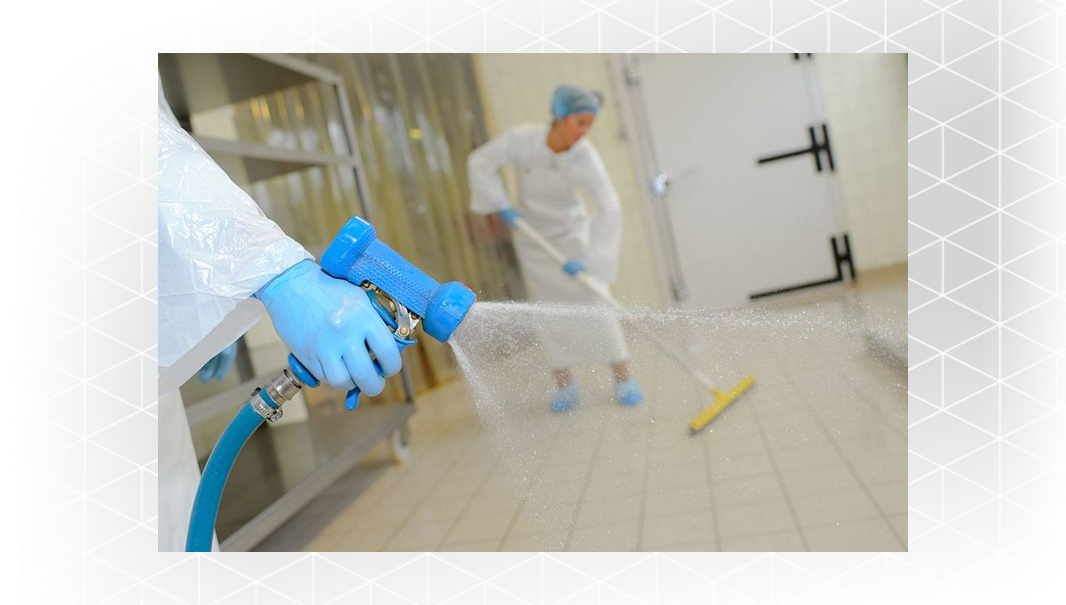Food & Beverage
In This Article
Read about the ways in which having a proper wash down system can boost your food safety measures, efficiency and promote industry best practices.

Food Safety Design for Employee Areas
One in six Americans get sick every year from eating contaminated foods, according to the Centers for Disease Control and Prevention. However, the problem is growing: Food safety regulators in the U.S. are recalling about twice as many products now compared to a decade ago.
While there are numerous best practices for incorporating food safety into the actual processing, employee welfare areas are a critical point of potential risk that can’t be ignored. This is especially true for facilities that have raw and ready-to-eat (RTE) operations. When trying maximize food safety in these spaces, consider the various touch points employees encounter at a facility.
Entering the building
Food safety begins the moment employees step into the building. Some facilities opt to have a secured entrance with a security guard and/or turnstile. This helps ensure only authorized individuals enter the plant. It also can set a tone of seriousness for plant employees the moment they arrive at work.
We’ve designed plants with a single entrance that serves as a point of control with the separation of raw and RTE employees occurring afterwards. Other plants have separate entrances for raw and RTE employees altogether. Either way, controlling access to areas with a card swipe is recommended. This helps ensure food safety by controlling who is in the plant and where.
Accessing the plant floor
Before they can enter the plant floor, employees must change and pass through “clean areas.” Facilities with both raw and RTE operations should have separate locker room for those employees to change and gown up. (These employees should also have separate restrooms and break rooms.)
One option is to include a bench in the changing area that serves as a dividing line between “street clothes” and “work clothes.” In this scenario, employees remove their footwear and/or outerwear on one side of the bench before turning around and putting on their smock and work boots on the other side of the bench. This helps ensure work and personal clothes never touch one another.
How a facility handles work boots is also an important consideration:
- Does the company provide boots?
- Do employees wash the boots and leave them overnight?
- Is there a boot station in the locker room?
After changing, employees must go through a “clean area” before entering the plant floor. This stage often involves a boot wash, hair nets, and a hand-washing station.
Lunch and break room best practices
No smocks in the break room
Many facilities do not allow employees to wear their smock in the break room. It could be as simple as a row of hooks outside the door, but the goal is to avoid smocks used in the processing area from entering a break room or bathroom. Again, a facility must have separate break rooms and bathrooms if they have raw and RTE employees.
Packing a lunch
To minimize the risk from outside contaminants, many plants don’t want employees to leave the facility once they enter. Of course, this means they need to pack a lunch (e.g., no food trucks, delivery, eating out). When arriving, employees should also store their lunch in a designated area of the break room–not in the locker room–to avoid cross-contamination.
Break room trash flow
It’s important to consider how the break room trash will be taken out. It can’t be carried out through food safe areas. The route from the break room to the dumpster must be carefully planned.
Plant visitor best practices
Visitors to the facility are crucial because they’re likely not familiar with the food safety routines and standards required in a food plant. Many facilities also include a training area to explain the rules to visitors and what they will be wearing to ensure food safety is maintained. Some companies have a designated locker room for visitors to store their personal belongings, gowns, and smocks.
Other considerations
We have had some clients request that we design color-coding into the facility to differentiate the raw from the RTE side of the plant. For example, if the raw side is assigned the color red, we could include, among other things:
- Doors leading to raw areas are marked red
- Striping on the floors in raw areas are marked red
- Employees working in raw areas wear red smocks.
The RTE side would be similar but in the color blue, for example. These visual cues for employees can serve as an extra layer of protection in preventing cross-contamination.
Karishma Kaulige, architectural intern, Stellar. This article originally appeared on the Stellar Food for Thought blog. Stellar is a CFE Media content partner.
View the original article and related content on Plant Engineering


 Find a Service Center
Find a Service Center